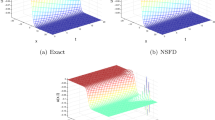Abstract
We propose explicit and conditionally stable combined numerical method based on using of both the conservative finite-difference scheme and non-conservative Rosenbrock method, for solving of 1D and 2D nonlinear Schrödinger equation. Each of these finite-difference schemes has own advantages and disadvantages. The conservative finite-difference scheme is implicit, conservative and possesses the property of asymptotic stability and the second order of approximation. The Rosenbrock method is conditionally conservative, explicit and possesses the same order of approximation in spatial coordinate only. Proposed finite-difference scheme is explicit and more effective for some cases.
The main idea of the combined method consists in using the Rosenbrock’s method near the boundaries of the domain. It means, that we introduce certain sub-domains near the boundaries of the domain under consideration. In other part of the domain, the conservative finite-difference scheme is used for computation. The problem solution is provided in several stages. In the first stage the problem solution is computed in the sub-domains at using the finite-difference scheme based on the Rosenbrock method with artificial boundary conditions (ABCs). Note, that for the first time layer we use the initial complex amplitude distribution. The second stage consists in the problem solution at using the conservative finite-difference scheme with boundary conditions (BCs) defined at the previous stage. Then, we repeat these stages by using the results obtained at using the conservative finite-difference scheme as the initial condition and using the results obtained on the base of Rosenbrock method as the BC for the solution computation on the next time layers.
Access this chapter
Tax calculation will be finalised at checkout
Purchases are for personal use only
Similar content being viewed by others
References
Trofimov, V.A., Trykin, E.M.: Combined method for solving of 1D nonlinear Schrödinger equation. In: Mastorakis, N., Mladenov, V. (eds.) Computational Problems in Engineering. LNEE, vol. 307, pp. 173–187. Springer, Cham (2014). https://doi.org/10.1007/978-3-319-03967-1_14
Karamzin, Y.N.: Difference schemes for computations of three-frequency interactions of electromagnetic waves in a nonlinear medium with quadratic polarization. Zh. Vychisl. Mat. Mat. Fiz. 14(4), 1058–1062 (1974)
Rosenbrock, H.H.: Some general implicit processes for the numerical solution of differential equations. Comput. J. 5(4), 329–330 (1963). https://doi.org/10.1093/comjnl/5.4.329
Tereshin, E.B., Trofimov, V.A., Fedotov, M.V.: Conservative finite difference scheme for the problem of propagation of a femtosecond pulse in a nonlinear photonic crystal with non-reflecting boundary conditions. Comput. Math. Math. Phys. 46, 154–164 (2006). https://doi.org/10.1134/S0965542506010155
Fibich, G.: The Nonlinear Schrödinger Equation: Singular Solutions and Optical Collapse. AMS, vol. 192. Springer, Cham (2015). https://doi.org/10.1007/978-3-319-12748-4
Arnold, A., Ehrhardt, M., Sofronov, I.: Discrete transparent boundary conditions for the Schrödinger equation: fast calculation, approximation, and stability. Commun. Math. Sci. 1(3), 501–556 (2003)
Jiang, S., Greengard, L., Sofronov, I.: Efficient representation of nonreflecting boundary conditions for the time-dependent Schrödinger equation in two dimensions. Commun. Pure Appl. Math. 61(2), 261–288 (2007)
Xu, Z., Han, H., Wu, X.: Adaptive absorbing boundary conditions for Schrödinger-type equations: application to nonlinear and multi-dimensional problems. J. Comp. Phys. 225(2), 1577–1589 (2007). https://doi.org/10.1016/j.jcp.2007.02.004
Han, H., Yin, D., Huang, Z.: Numerical solutions of Schrödinger equations in R3. Numer. Methods Part. Differ. Eq. Int. J. 23(3), 511–533 (2006). https://doi.org/10.1002/num.20193
Antoine, X., Besse, C., Mouysset, V.: Numerical schemes for the simulation of the two-dimensional Schrödinger equation using non-reflecting boundary conditions. Math. Comput. 73(248), 1779–1799 (2004). https://doi.org/10.2307/4100054
Zheng, C.: Exact nonreflecting boundary conditions for one-dimensional cubic nonlinear Schrödinger equations. J. Comp. Phys. 215(2), 552–565 (2006). https://doi.org/10.1016/j.jcp.2005.11.005
Soffer, A., Stucchio, C.: Open boundaries for the nonlinear Schrödinger equation. J. Comp. Phys. 225(2), 1218–1232 (2007). https://doi.org/10.1016/j.jcp.2007.01.020
Xu, Z., Han, H.: Absorbing boundary conditions for nonlinear Schrödinger equations. Phys. Rev. E 74(3), 037704 (2006). https://doi.org/10.1103/PhysRevE.74.037704
Fevens, T., Jiang, H.: Absorbing boundary conditions for the Schrödinger equation. SIAM J. Sci. Comput. 21(1), 255–282 (1999). https://doi.org/10.1137/S1064827594277053
Li, H., Guo, Y.: Numerical solution of the general coupled nonlinear Schrödinger equations on unbounded domains. Phys. Rev. E 96, 063305 (2017). https://doi.org/10.1103/PhysRevE.96.063305
Yang, X., Zhang, J.: Computation of the Schrödinger equation in the semiclassical regime on an unbounded domain. SIAM J. Numer. Anal. 52(2), 808–831 (2014). https://doi.org/10.1137/13090715X
Trofimov, V.A., Trykin, E.M.: Construction of adaptive artificial boundary conditions using the invariant ratios for Schrödinger equation. In: 2014 East-West Design Test Symposium (EWDTS), pp. 1–4 . IEEE Conference Publications (2014). https://doi.org/10.1109/EWDTS.2014.7027098
Acknowledgments
Supported by the Russian Science Foundation (Grant 14-21-00081).
Author information
Authors and Affiliations
Corresponding author
Editor information
Editors and Affiliations
Rights and permissions
Copyright information
© 2019 Springer Nature Switzerland AG
About this paper
Cite this paper
Trofimov, V.A., Trykin, E.M. (2019). Explicit and Conditionally Stable Combined Numerical Method for 1D and 2D Nonlinear Schrödinger Equation. In: Dimov, I., Faragó, I., Vulkov, L. (eds) Finite Difference Methods. Theory and Applications. FDM 2018. Lecture Notes in Computer Science(), vol 11386. Springer, Cham. https://doi.org/10.1007/978-3-030-11539-5_64
Download citation
DOI: https://doi.org/10.1007/978-3-030-11539-5_64
Published:
Publisher Name: Springer, Cham
Print ISBN: 978-3-030-11538-8
Online ISBN: 978-3-030-11539-5
eBook Packages: Computer ScienceComputer Science (R0)




